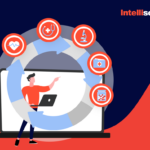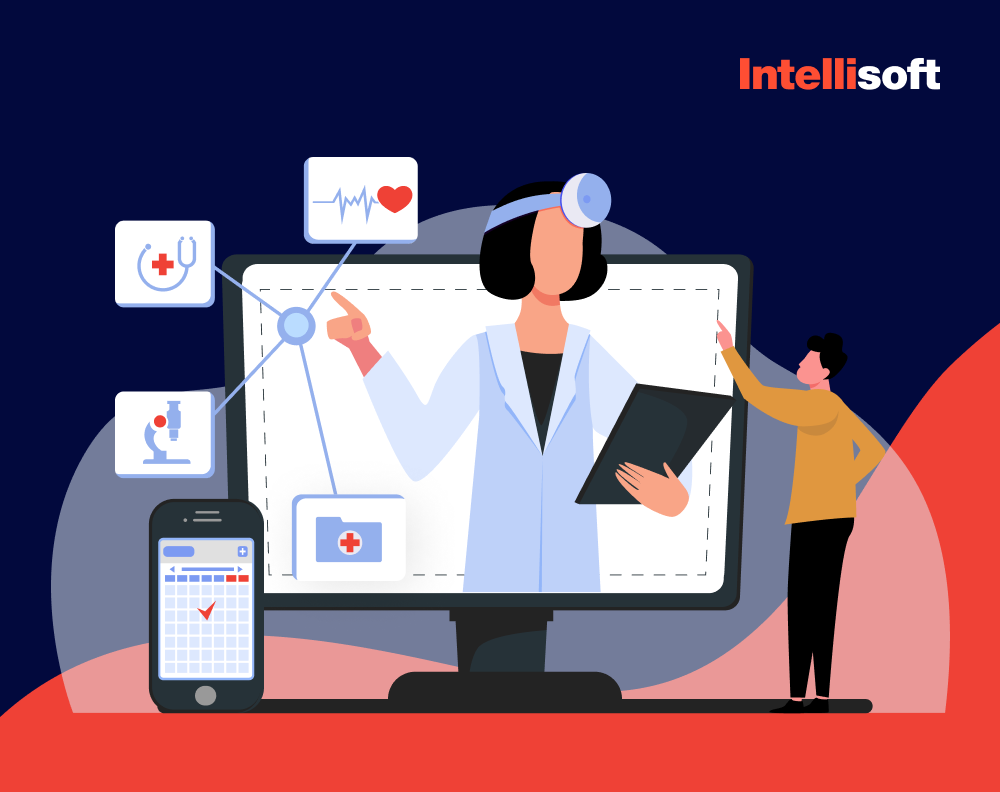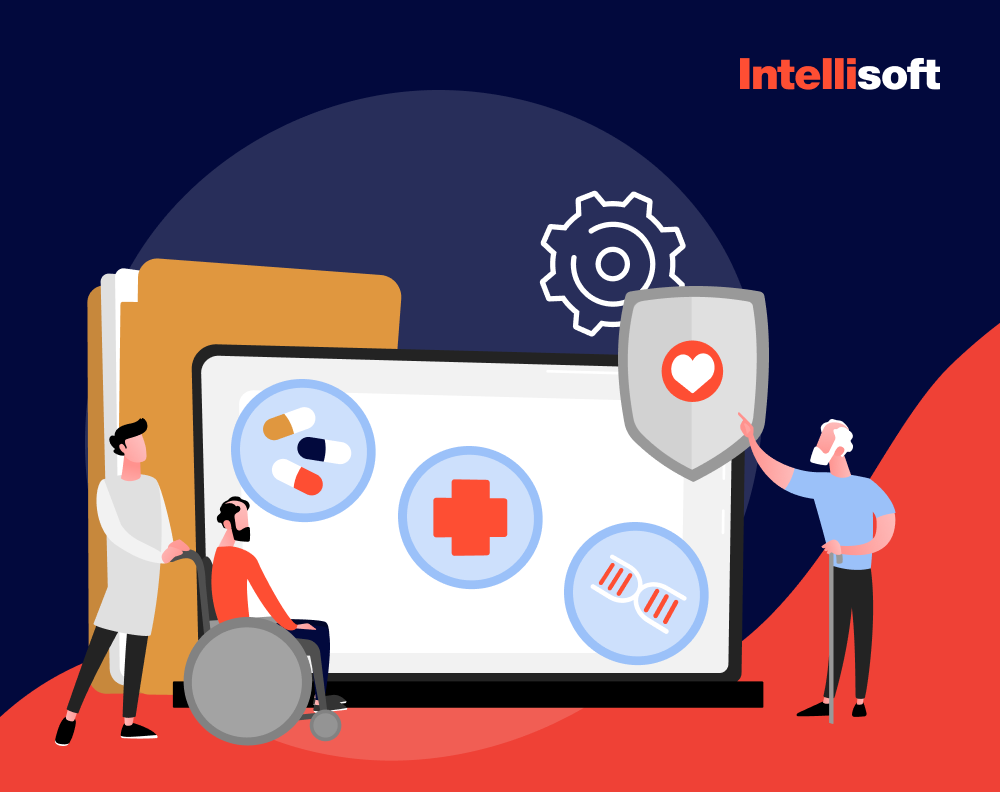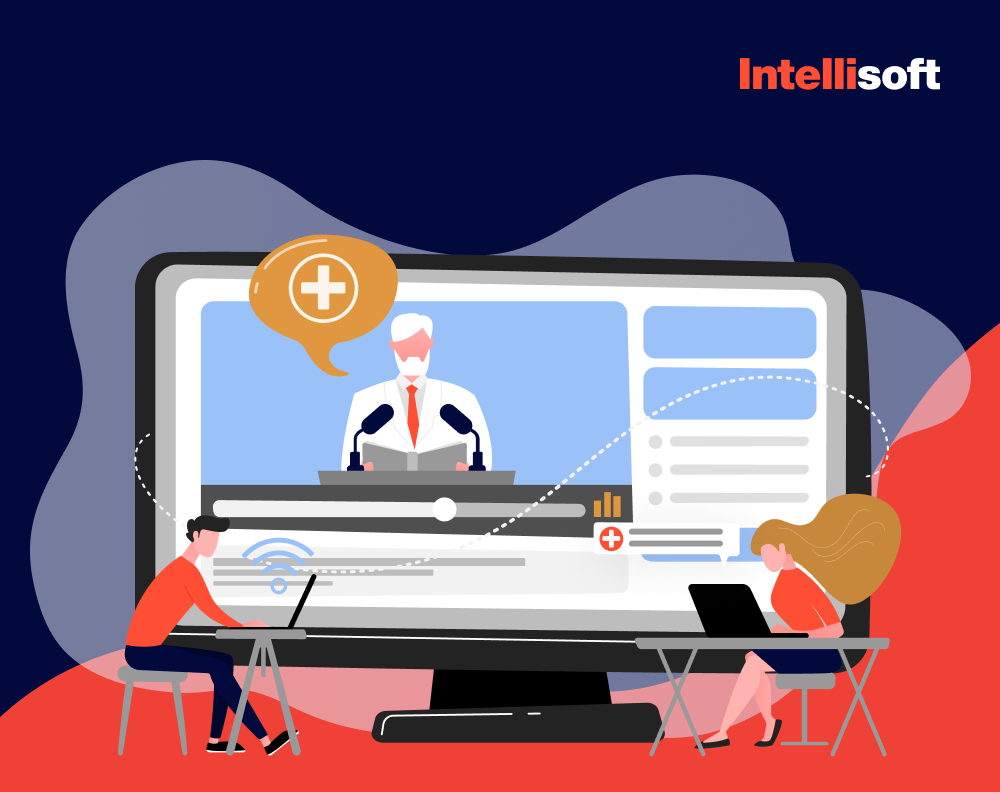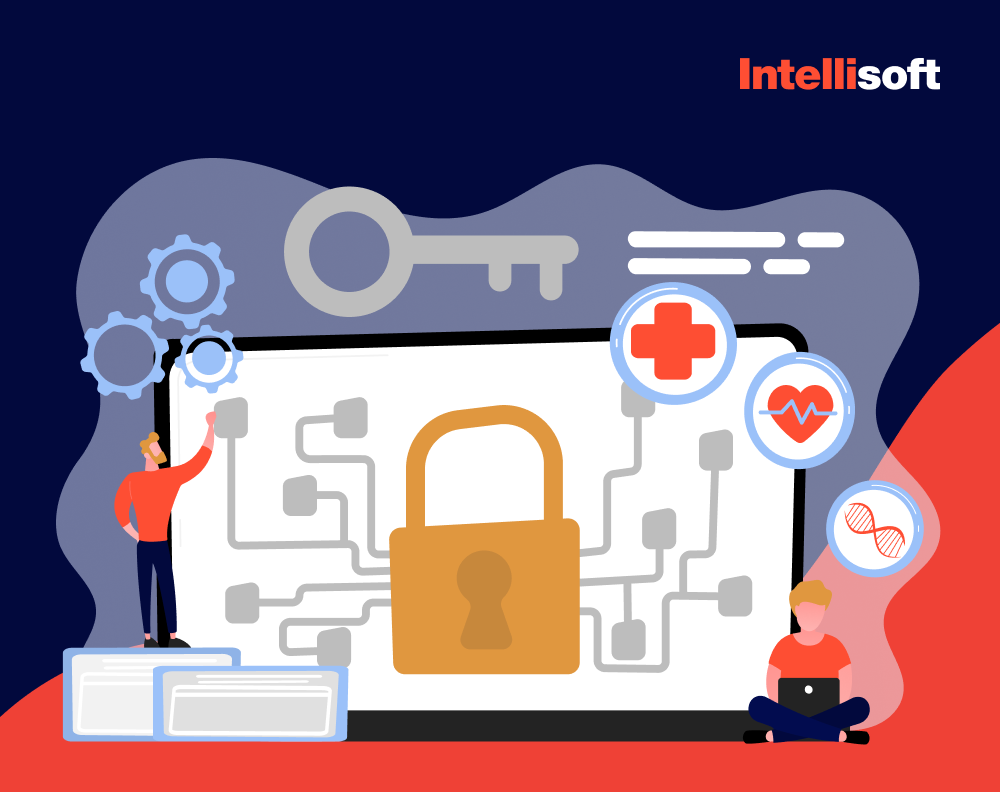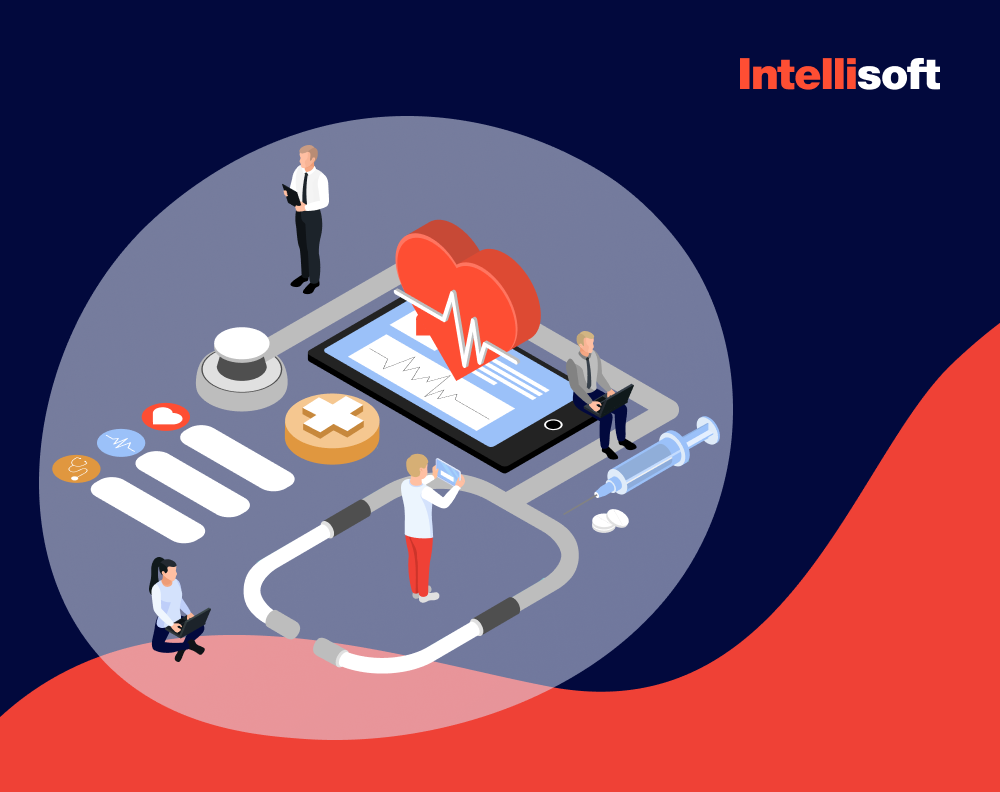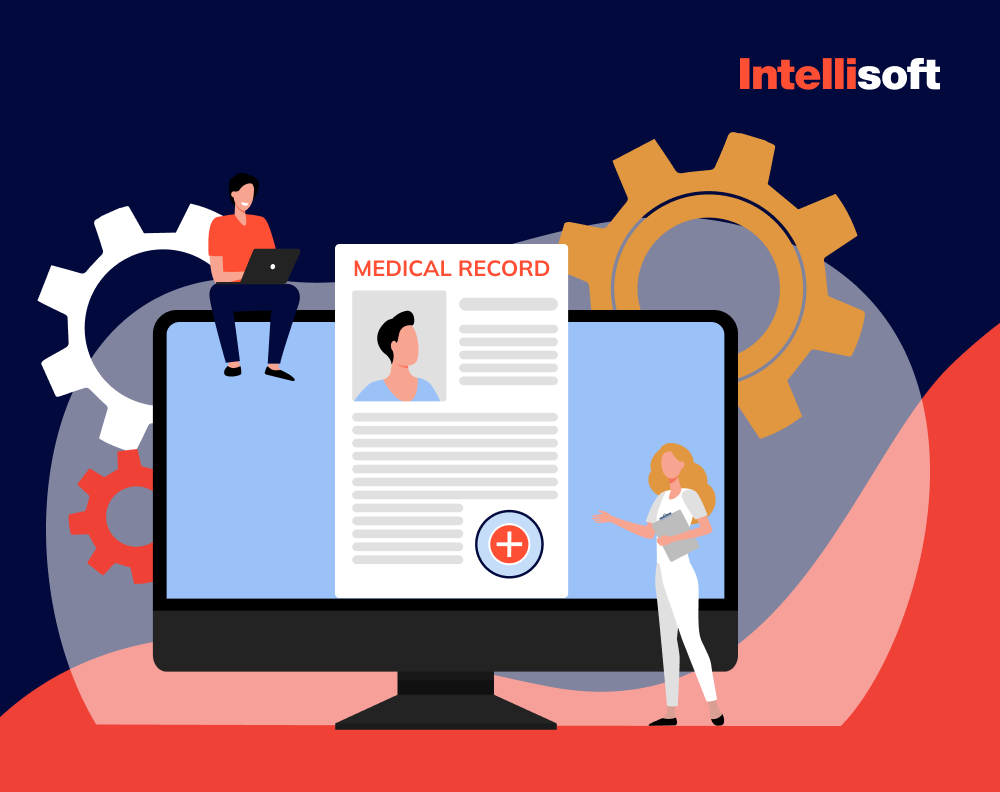The use of the Internet of Things (IoT) in healthcare has proven to be groundbreaking and life-changing. From smart wearable devices and well-being monitoring, to smart hospital beds, the Internet of Things in healthcare is no longer an option but is necessary to improve patient care and treatment.
However, with any great technology come great challenges, and IoT is no exception. Since IoT is an infrastructure of internet-connected devices, these devices are prone to security issues, driving the need for enhanced Healthcare IoT Security measures.
How do you ensure that the Internet of Things devices help your healthcare organizations grow and prosper, without compromising patient data? How do you protect the lifeblood of your business and fight off any cyber security challenges in IoT in healthcare and attacks on data? The answer is – future-proof IoT protection measures.
Fortunately, you don’t have to approach this matter alone – Intellisoft is here to help. With more than 13 years of experience in healthcare and IoT, our experts know how to tackle any security issue and keep your data protected and in place. Let’s embark on this journey together and ensure that none of your patient data is vulnerable to protection threats.
Table of Contents
Healthcare IoT Security Market Size
Currently, the Healthcare IoT Security Market size is valued at about $2.4 billion and is expected to grow at a CAGR of 21% by 2034, reaching $16.2 billion. The growth of healthcare IoT security industry is explained by the rapid increase in wearable devices and smart healthcare infrastructure that needs to be protected from protection breaches. Moreover, healthcare organizations are undergoing digital transformation to improve patient care and optimize their workflows, and they require modern security approaches to support their initiatives.
What is Healthcare IoT Security?
Medical device IoT security refers to the measures and protocols put in place to protect the interconnected devices, networks, and systems used in healthcare settings from cyber threats and unauthorized access.
The Internet of Things devices in healthcare include a wide range of equipment, such as medical sensors, monitors, infusion pumps, wearable devices, and more, which are connected to the internet or to each other to collect, transmit, and analyze patient data in real-time. While these devices offer numerous benefits, such as remote patient monitoring, improved treatment outcomes, and operational efficiency, they also present significant security risks.
IoT healthcare security measures include encrypting data, implementing access controls, segmenting networks, updating software regularly, monitoring for anomalies, authenticating devices, enforcing physical protection, managing vendor risks, ensuring regulatory compliance, and providing employee training. These measures collectively protect patient data and maintain the integrity of IoT healthcare security systems.
Why Healthcare IoT Security is Important?
Medical device IoT security is vital, given the widespread integration of the Internet of Things devices in healthcare, particularly with the surge in remote patient monitoring due to the COVID-19 pandemic. While these devices offer benefits such as improved access to healthcare and remote monitoring, they also raise concerns about data protection and privacy.
The rapid adoption of the Internet of Things devices in healthcare has led to revealing IoT devices healthcare security vulnerability, with many lacking robust protection measures. This exposes healthcare organizations to cyberattacks, such as ransomware, which can disrupt medical services and compromise patient safety. Moreover, the responsibility for medical IoT data breaches remains ambiguous, adding to the complexity of addressing security issues in IoT healthcare.
To mitigate these risks, healthcare institutions and the Internet of Things manufacturers must implement effective security measures, including robust authentication mechanisms, encryption of sensitive data, and adherence to industry guidelines for cybersecurity. Collaboration between regulatory bodies, industry organizations, and stakeholders is crucial to addressing these challenges and improving the security of the Internet of Things devices in healthcare.
Growth Prospects and Trends in the Healthcare IoT Security Industry
The future of IoT medical device security is promising, with significant growth prospects and emerging trends shaping the industry landscape. The demand for robust security measures is expected to increase as the healthcare sector continues to embrace IoT technologies for improved patient care and operational efficiency.
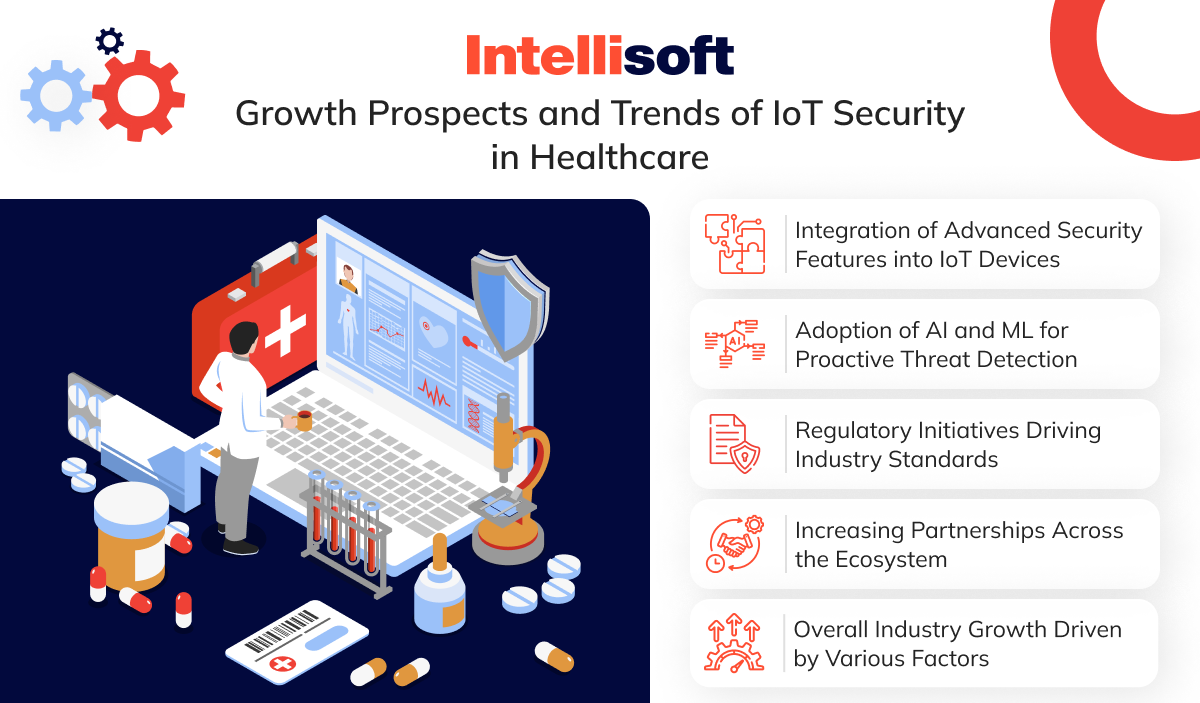
Growth prospects and trends of IoT security in healthcare include:
- Integration of Advanced Security Features into IoT Devices. Incorporating encryption, authentication, and intrusion detection capabilities directly into the Internet of Things devices enhances their resistance against cyber threats.
- Adoption of AI and ML for Proactive Threat Detection. Utilizing artificial intelligence and machine learning enables real-time identification of security risks, improving cybersecurity posture overall.
- Regulatory Initiatives Driving Industry Standards. Regulatory bodies such as the International Medical Device Regulators Forum (IMDRF) and organizations such as the National Institute of Standards and Technology (NIST) are establishing guidelines to ensure compliance and standardization in healthcare IoT security.
- Increasing Partnerships Across the Ecosystem. Collaborations between healthcare providers, technology vendors, and cybersecurity firms are becoming more prevalent, resulting in the development of tailored healthcare IoT security solutions that meet the unique needs of the healthcare industry.
- Overall Industry Growth Driven by Various Factors. Technological advancements, evolving regulatory landscapes, and a heightened awareness of cybersecurity risks, are contributing to the significant growth prospects in the IoT medical device security industry.
Related Readings:
- The Internet of Things (IoT) in Health Care
- What is EHR Software? Build Your Custom System and Digitize Doctor’s Scribbles with IntelliSoft
- 9 Technological Trends in Healthcare in 2023
- IoT in Healthcare: Key Trends & Usages
- IoT Device Security Concepts: IntelliSoft’s Roadmap to Robust IoT Protection
Specific Medical Device IoT Security Threats
The widespread use of IoT in healthcare comes with a specific set of threats, the most common of which must be addressed. Let’s examine the medical device IoT security risks.
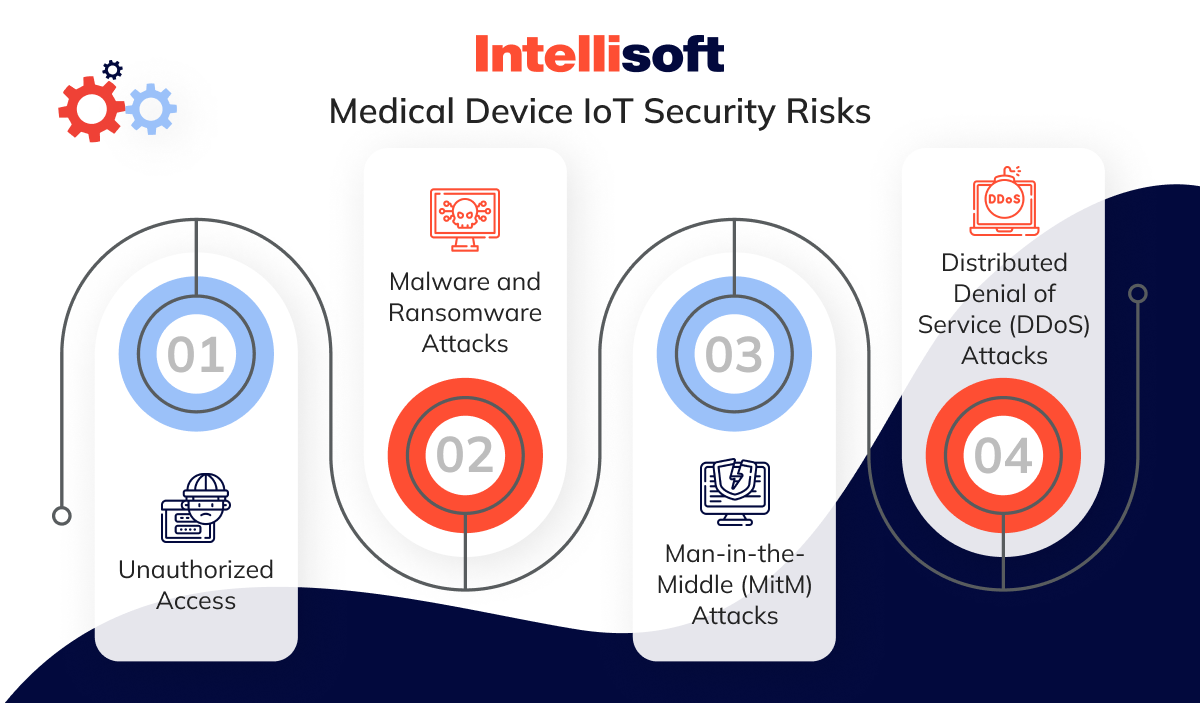
Unauthorized Access
Unauthorized access is one of the most common security issues with IoT devices in healthcare. Unfortunately, a lot of devices don’t have proper security features and come with default passwords, making them vulnerable to hacker attacks. These devices also don’t have two-factor authentication features, which is a must for all industries, not only healthcare.
Malware and Ransomware Attacks
Since the Internet of Things devices are interconnected, an attack on one link can spread through the entire system. That is why each link should be secured appropriately. Malicious software can infiltrate the Internet of Things devices, compromising their functionality and exposing sensitive patient data to unauthorized parties. Ransomware attacks, in particular, can encrypt medical records and demand ransom payments, disrupting healthcare operations and compromising patient care.
Man-in-the-Middle (MitM) Attacks
Man-in-the-Middle (MitM) attacks occur when an unauthorized third party intercepts communication between the Internet of Things devices and their intended recipients. By exploiting vulnerabilities in network protocols or device configurations, attackers can eavesdrop on sensitive data exchanges, manipulate information, or inject malicious content into communication streams, compromising the integrity and confidentiality of patient information.
Distributed Denial of Service (DDoS) Attacks
Last but not least, among the security and privacy issues with IoT in healthcare are distributed denial of service (DDoS) attacks. They pose a significant threat to healthcare IoT infrastructure by overwhelming network resources and disrupting service availability. Attackers can exploit vulnerabilities in the Internet of Things devices to enlist them in botnets, orchestrating coordinated attacks aimed at flooding healthcare networks with malicious traffic. These attacks can impair critical healthcare services, causing disruptions in patient care delivery and compromising the integrity of medical systems.
Ways Hospitals Can Help Improve Their IoT Security
At least 75% of healthcare organizations have one vulnerability or security alert. Besides challenging security issues, IoT systems don’t always comply with the security requirements of laws such as HIPAA. However, some strategies can help hospitals address these problems and improve their IoT healthcare security; let’s explore them.
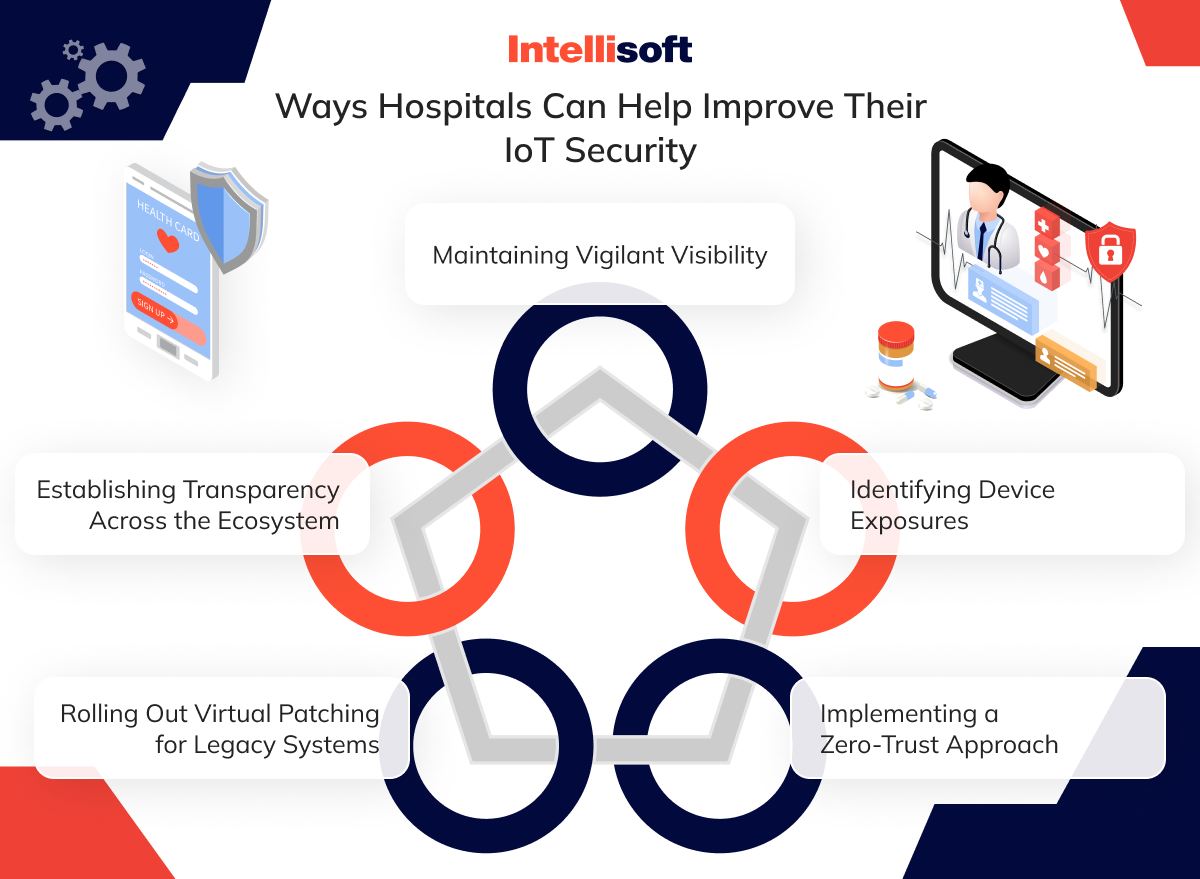
Maintaining Vigilant Visibility
The first step hospitals and healthcare organizations should take is to establish complete visibility of all elements of the IoT network. That’s the task of biomed and infosec teams; they need a complete picture of the assets used in the hospital’s network and how they are connected with each other. When they know about the number of devices and their connection, it’s time to focus on the key applications and components that are underneath the OS. These applications usually include EHRs, picture archiving, and communication systems (PACS).
Identifying Device Exposures
There are two main types of vulnerabilities devices are prone to; static and dynamic. Static exposures, consisting of Common Vulnerabilities and Exposures, can be addressed independently. Dynamic exposures, on the other hand, are more challenging to identify and address. However, it is possible to use AI and automation to identify vulnerabilities and tackle them swiftly.
Implementing a Zero-Trust Approach
After identifying all the assets and their vulnerabilities, it’s time to implement a ZT approach to address any challenges to healthcare IoT security. This approach proposes limiting access to vulnerable devices and apps, only allowing certain professionals to access them. The devices are placed into different segments based on their vulnerability levels, so it becomes easier to manage accesses, requirements, and security controls.
Rolling Out Virtual Patching for Legacy Systems
A lot of medical devices run on legacy software and systems, and some hospitals may not be able to upgrade or patch those systems, leading to more security issues. Investing in ZT approach allows hospitals to use other forms of protection, such as virtual patching in case if it’s impossible to take the device offline for patching.
Establishing Transparency Across the Ecosystem
One of the main approaches for preventing threats and IoT security healthcare issues is establishing a high level of transparency and communication in the organization. When hospitals buy devices, they need to involve their security teams because they know best how to keep the devices safe over time. Hospitals, security teams, device sellers, and manufacturers must work together. They need to develop plans and ideas to make sure that security is a big priority for medical devices.
How IntelliSoft Can Help with Healthcare IoT Security
If you have been looking for a tech partner to guide you through the journey of medical device IoT security, you don’t have to search anymore; IntelliSoft is here to help. With more than 13 years of experience in the healthcare and the Internet of Things industries, our team knows all the intricacies of IoT medical device security, ready to address any challenges your organization may face.
Here’s how we can assist:
Comprehensive Security Solutions
Leveraging our extensive experience, IntelliSoft offers a range of comprehensive security solutions tailored specifically for the healthcare sector. These solutions address the unique challenges and requirements of securing the Internet of Things devices in medical environments.
Advanced Threat Detection
At IntelliSoft, we don’t just detect threats; we anticipate and outmaneuver them. Our advanced threat detection capabilities harness the power of cutting-edge technologies such as artificial intelligence and machine learning, offering proactive defense against emerging security risks.
Regulatory Compliance
One of our main strengths is navigating the labyrinth of healthcare regulations. IntelliSoft ensures seamless compliance with ever-evolving regulatory frameworks, providing our clients with peace of mind and a shield against regulatory pitfalls.
Collaborative Approach
Security is a collective endeavor. IntelliSoft cultivates a culture of shared responsibility and mutual support in safeguarding healthcare IoT ecosystems by fostering collaboration among healthcare providers, device manufacturers, and industry stakeholders.
Continuous Improvement
Our commitment to innovation is not just about finding solutions; it’s about starting a journey towards them. At IntelliSoft, we embrace a culture of continuous improvement, constantly pushing the boundaries of what’s achievable in IoT for healthcare cyber security. With an unwavering determination to evolve, we equip our clients with the tools and knowledge to stay ahead of the curve and confidently embrace the future.
Ready to collaborate with a security provider and architects of trust and partners in progress? Contact us now, and let’s build a smarter, more secure future for your healthcare organization.

